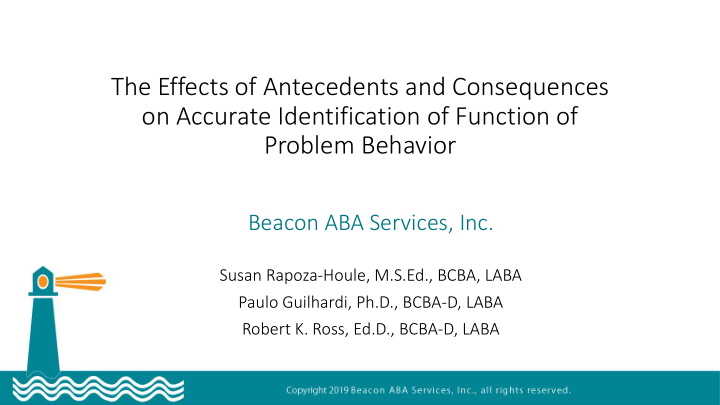



The Effects of Antecedents and Consequences on Accurate Identification of Function of Problem Behavior Beacon ABA Services, Inc. Susan Rapoza-Houle, M.S.Ed., BCBA, LABA Paulo Guilhardi, Ph.D., BCBA-D, LABA Robert K. Ross, Ed.D., BCBA-D, LABA
HELP HELP WANTED WANTED
Classroom Fieldwork Model Instruction Model Instruction Written Skill Sheet Slides Video Repeated Competency Checklist Examples Demonstration Live demo Feedback Rehearsal Feedback Rehearsal Sr+ and Staff Corrective Supervision Role Competency With Client Form Play Checklist
Competency Image
Carter, O'Rourke, Sisco & Pelsue (2009)
Horner 1994 Problem behavior involves complex interactions among controlling variables. Individual problem behaviors may be maintained by more than one mechanism A group of problem behaviors may be members of a single response class
Scott, Lerman, and Luck 2018 Relevant antecedents and consequences may take a variety of forms Events may be subtle More than one antecedent or consequence can occur simultaneously
It can be challenging for those with limited training in the science of behavior to discriminate between relevant and irrelevant stimuli when forming hypotheses of function
“ A connection between an operant and a reinforcing stimulus can be established independently of any specific stimulation acting prior to the response.” The Behavior of Organisms p. 177
Selection Selection By By Conseq Consequen uences ces
Does antecedent information affect the accurate identification of escape and attention functions by observers with limited experience?
Participants
Materials
C B A OR
Subtitles Antecedent I know you hate I know you are tired this but you have to but it’s time to play play with your with your shape shape sorter sorter Play with that Why don’t you play brand new shape with your new sorter you bought shape sorter, you with your birthday love it so much money yesterday
Subtitles No I don’t want I don’t feel like Behavior to it Please do it Will you please with me play too?
Subtitles Consequence __________ ___________ I will do it with It is nice to play you together
Data Sheet
Research Design Multielement Design
Independent Variable Condition 1: Consistent E E A A
Independent Variable Condition 2: Inconsistent E A A E
n=18 Consistent Inconsistent 100% 92% 89% 90% 80% 70% 60% Accuracy 50% 44% 40% 30% 25% 20% 10% 0% AA EE AE EA Antecedent/Consequence Condition
Consequence Control 100 90 80 Percent Correct 70 60 50 40 30 20 10 0 1 2 3 4 5 6 7 8 9 10 11 12 13 14 15 16 Trials
Consequence Control 100 90 80 Percent Correct 70 60 50 40 30 20 10 0 1 2 3 4 5 6 7 8 9 10 11 12 13 14 15 16 Trials Consistent(AA,EE) Inconsistent (AE,EA)
Antecedent Control 100 90 80 Percent Correct 70 60 50 40 30 20 10 0 1 2 3 4 5 6 7 8 9 10 11 12 13 14 15 16 Trials Consistent(AA,EE) Inconsistent (AE,EA)
Consistent is Accurate Inconsistent is Variable 100 90 80 Percent Correct 70 60 50 40 30 20 10 0 1 2 3 4 5 6 7 8 9 10 11 12 13 14 15 16 Trials Consistent(AA,EE) Inconsistent (AE,EA)
Shifting Control 100 90 80 Percent Correct 70 60 50 40 30 20 10 0 1 2 3 4 5 6 7 8 9 10 11 12 13 14 15 16 Trials Consistent(AA,EE) Inconsistent (AE,EA)
Undetermined Control 100 90 80 Percent Correct 70 60 50 40 30 20 10 0 1 2 3 4 5 6 7 8 9 10 11 12 13 14 15 16 Trials Consistent(AA,EE) Inconsistent (AE,EA)
Discussion the cause of the error may not be clear
Discussion The ability to pinpoint controlling stimuli is essential to treatment
Discussion This procedure was efficient
Considerations Participants completed the assessment under differing conditions Participants were asked to hypothesize function based upon the current trial only
How is each type of error May be helpful in other applications, such as best remediated? parent training and support
References • Carter, E. W., O'Rourke, L., Sisco, L. G., Pelsue, D. (2009). Knowledge, responsibilities, and training needs of paraprofessionals in elementary and secondary schools. Remedial and Special Education , 30 , 344-359. • Horner, R.H. (1994). Functional Assessment: Contributions and future directions. Journal of Applied Behavior Analysis , 27(2),401-404. • Parsons, M. B., Rollyson, J. H., & Reid, D. H. (2012). Evidence-based staff training: A guide for practitioners. Behavior Analysis in Practice, 5(2), 2-11. Providers’ Council/University of Massachusetts Donahue Institute/University of • Massachusetts Dartmouth Center for Public Policy. (2017). Who will care? The Workforce Crisis in Human Services. Boston, MA. • Reichow, B. (2012). Overview of meta-analyses on early intensive behavioral intervention for young children with autism spectrum disorders. Journal of Autism and Developmental Disorders, 42(4), 512 – 20. • Scott, J., Lerman, D.C., Luck, K. (2018). Computer-based training to detect antecedents and consequences of problem behavior. Journal of Applied Behavior Analysis , 51(4), 784-801. • Skinner, B. F. (1938). The behavior of organisms: An experimental analysis . New York, London: D. Appleton-Century Company, Incorporated. Skinner, B. F. (1981). Selection by consequences. Science 213: 501-4. •
Recommend
More recommend